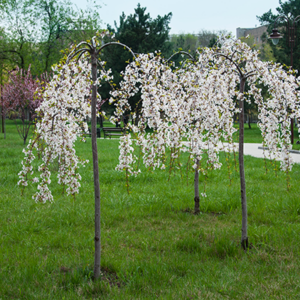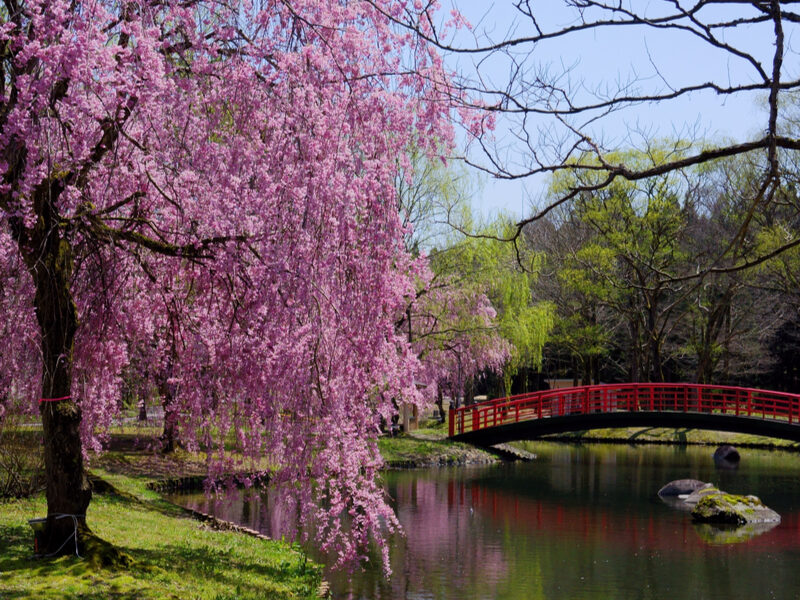Why You Should Consider A Weeping Cherry Tree For Your Michigan Yard
Cherry trees are a Michigan icon. From the festivals in Traverse City to the characteristic pink blooms in spring, cherry trees are one of the loveliest plants to have in your Michigan garden. In fact, if you’re thinking of adding a new tree to your yard, why not consider the Weeping Cherry Tree? It doesn’t require extensive tree care, and you’ll be rewarded with a splash of color in spring!
Why Weeping Cherry Trees Make A Great Addition To Any Yard
They Won’t Interfere With Infrastructure
One of the best things about weeping cherry trees is their root system. Unlike some other tree species, weeping cherry trees have a non-aggressive root system. This means that the root system does not spread quickly, so you won’t have to worry about your new plant messing with property lines, sewers, pavement, or other ornamental plants. It’s also tolerant of handling variations in moisture, which means you can plant this tree near a septic system, and it won’t interfere with the plumbing!
Weeping Cherries Provide Year-round Color
One drawback of getting a flowering tree is that the flowers are only around for a set period of time. With weeping cherries, however, you’ll get a dazzling show of color not only from the blossoms but the rest of the tree as well. In spring, you’ll get the characteristic pink flowers. In summer, the leaves are a lovely, glossy green. In fall, they’ll turn a vibrant gold. And in winter, even though the tree has lost its leaves and flowers, the bark itself puts on a show by turning bronze.
Weeping Cherries Are Low Maintenance
If you don’t have the time, energy, or desire to spend a great deal of time taking care of a tree, this is the plant for you. Weeping cherries are adaptable to a wide range of conditions. When it comes to the sun, they can handle full direct light or partial shade. In the soil department, they are also tolerant. They prefer loose, well-drained, loamy soil but are also fairly forgiving of dry conditions, which is needed during the hot Michigan summers. When it comes to pruning, less is more! Unless a branch is dead or dying, in which case you should prune it right away, you don’t want to prune your tree too often. The long sweeping branches of this tree are what make it so graceful. By cutting the branches, you’ll ruin the look!
Weeping Cherry Trees Are Good Growers
You can expect your tree to reach 20 – 30 feet in height with about equal spread at maturity. They typically grow between one and two feet each year, which means you won’t have to wait terribly long to have some shade in addition to beauty.
Weeping Cherries Help Pollinators
All those flowers that bloom in spring will help the declining pollinator population. Bees and butterflies alike will love the food source you’ve provided them. There is one catch: the cherries they produce are inedible, so if you’re looking to have cherries you can actually eat, you might want to consider a different varietal.
Planting And Caring For Your Weeping Cherry Tree
As mentioned above, your tree can handle full sun or partial shade. However, if you can manage a full-sun spot, that would be the best option. Ideally, it likes to have 6 hours of direct light. In partial shade, the blooms may not be as plentiful. You should also make sure not to plant your tree too close to fences or walls. The weeping branches might get cramped and dented against these structures. You should also leave about 10 feet of space between the tree and your home. Even though they don’t have aggressive roots, they still have roots. And you don’t want them heading towards the foundation.
You’ll want to dig a hole that is as deep as the root ball and twice as wide. When placing the tree, make sure the trunk’s base is level with the surrounding soil. Fill the hole with soil halfway, tamping it down to remove air pockets. Before filling in the rest of the hole, pour water in, wait until it drains completely, and then fill in the rest of the hole.
Watering
During the first year of its life, you’ll want to water your weeping cherry tree deeply twice a week. Deeply meaning for 30 – 45 minutes. Shallow watering teaches the roots to stay near the surface instead of growing deep into the earth. When you water too frequently, you’re essentially teaching the tree that it doesn’t have to wait long for its next meal. By watering deeply and infrequently, you’ll teach it to be tough and withstand brief periods of no rain. After the first year of its life, you only need to water during periods of high temps and/or drought.
Mulching
Adding mulch around the base of your tree can help it retain moisture during dry periods. You’ll only need about 3 inches, any more than that, and you run the risk of mold or mildew problems. You should also be sure to leave 6 inches from the base of the trunk. And you definitely shouldn’t create a “mulch volcano.” Many people think that more is better when it comes to mulch, but this is not the case. By dumping more mulch than is necessary, you’re actually trapping too much moisture, which can lead to insect problems, disease, and most importantly, root rot, a condition that can lead to the removal of your tree if it is severe enough.
Fertilizer
In spring, slow-release fertilizer is a great way to ensure your tree will have time-released nutrients that last for a while. If you’re not sure which fertilizer to choose, leave it to us! PPM Tree Service & Arbor Care offers tree and shrub care that includes everything from planting new trees to removing dead ones.
Get Professional Tree And Shrub Care Services Near Canton
If you’re interested in adding a weeping cherry tree to your garden, give the experts at PPM Tree Service & Arbor Care a call! We’ll help you with the planting and care of your new ornamental and do all the heavy-lifting, so you don’t have to! All you have to do is sit back and enjoy the lovely new plant. To learn more, give us a call at (877) 454-8733 or leave us a message online. Don’t forget to check back next month for new blogs! We post articles twice a month. And you can connect with us on Facebook, Twitter, or even Pinterest.


